Non-Timber Forest Products in Brazil: A Bibliometric and a State of the Art Review
Abstract
1. Introduction
2. Materials and Methods
2.1. Bibliometric Review
2.2. State of the Art
3. Results and Discussion
3.1. Bibliometric Review
3.2. State of the Art
Considerations and Challenges of Brazilian Legislation on Non-Timber Forest Products
4. Conclusions
Author Contributions
Funding
Acknowledgments
Conflicts of Interest
References
- Alcântara, M.S.; Duarte, A.E.; Boligon, A.A.; Campos, M.M.A.; Lucena, R.F.P.; Pinheiro, M.A.; Cruz, D.D. Effects of different levels of exploration on the ecological processes of Dimorphandra gardneriana, a tropical savanna tree. Environ. Monit. Assess. 2020, 192, 378. [Google Scholar] [CrossRef] [PubMed]
- Muir, G.F.; Sorrenti, S.; Vantomme, P.; Vidale, E.; Masiero, M. Into the wild: Disentangling non-wood terms and definitions for improved forest statistics. Int. For. Rev. 2020, 22, 101–119. [Google Scholar] [CrossRef]
- Sills, E.; Shanlet, P.; Paumgarten, F.; Beer, J.; Pierce, A. Evolving perspectives on non-timber forest products. In Non-Timber Forest Products in the Global Contexto, 1st ed.; Shackleton, S., Shackleton, C.M., Shanley, P., Eds.; Springer: Berlin, Germany, 2011; pp. 23–51. [Google Scholar]
- Brasil. Lei nº 11.284, de 2 de Março de 2006. Lei de Gestão de Florestas Públicas. Dispõe Sobre a Gestão de Florestas Públicas para a Produção Sustentável; Institui, na Estrutura do Ministério do Meio Ambiente, o Serviço Florestal Brasileiro—SFB; cria o Fundo Nacional de Desenvolvimento Florestal—FNDF; Altera as Leis nºs 10.683, de 28 de Maio de 2003, 5.868, de 12 de dezembro de 1972, 9.605, de 12 de Fevereiro de 1998, 4.771, de 15 de Setembro de 1965, 6.938, de 31 de Agosto de 1981, e 6.015, de 31 de Dezembro de 1973; e dá Outras Providências; 2006. Available online: http://www.planalto.gov.br/ccivil_03/_ato2004-2006/2006/lei/l11284.htm (accessed on 1 July 2020).
- Brasil. Lei nº 12.651, de 25 de Maio de 2012. Institui o NOVO código Florestal Brasileiro; 2012. Available online: http://www.planalto.gov.br/ccivil_03/_ato2011-2014/2012/lei/l12651.htm (accessed on 1 July 2020).
- Fiedler, N.C.; Soares, T.S.; Silva, G.F. Produtos florestais não madeireiros: Importância e manejo sustentável da floresta. Rev. Ciênc. Exatas Nat. 2008, 10, 263–278. [Google Scholar]
- Sacande, M.; Parfondry, M. Non-Timber Forest Products: From Restoration to Income Generation; FAO: Rome, Italy, 2018; p. 40. [Google Scholar]
- Silva, N.; Martins, B.; Nagy, A.; Maciel, N. Políticas públicas do Brasil para produtos florestais não madeireiros. In The Overarching Issues of the European Space: A Strategic (Re)Positioning of Environmental and Socio-Economic; Faculdade de Letras da Universidade do Porto: Porto, Portugal, 2019; pp. 255–273. [Google Scholar]
- Brasil. Bioeconomia da Floresta: A Conjuntura da Produção Florestal Não Madeireira no Brasil; Ministério da Agricultura, Pecuária e Abastecimento—Serviço Florestal Brasileiro: Brasília, Brasil, 2019; 45p.
- Guariguata, M.R.; Cronkleton, P.; Duchelle, A.E.; Zuidema, P.A. Revisiting the ‘cornerstone of Amazonian conservation’: A socioecological assessment of Brazil nut exploitation. Biodivers. Conser. 2017, 26, 2007–2027. [Google Scholar] [CrossRef]
- Tejada, G.; Görgens, E.B.; Ovando, A.; Ometto, J.P. Mapping data gaps to estimate biomass across Brazilian Amazon forests. For. Ecosyst. 2020, 7, 1–15. [Google Scholar] [CrossRef]
- Cunha, A.M.; Fontes, M.P.F.; Lani, J.L. Mineralogical and chemical attributes of soils from the Brazilian Atlantic Forest domain. Sci. Agric. 2019, 76, 82–92. [Google Scholar] [CrossRef]
- Brasil. Lei nº 11.428, de 22 de Dezembro de 2006. Dispõe Sobre a Utilização e Proteção da Vegetação Nativa do Bioma Mata Atlântica, e dá Outras Providências; 2006. Available online: http://www.planalto.gov.br/ccivil_03/_Ato2004-2006/2006/Lei/L11428.htm (accessed on 1 July 2020).
- Hidasi-Neto, J.; Joner, D.C.; Resende, F.; Monteiro, L.M.; Faleiro, F.V.; Loyola, R.D.; Cianciaruso, M.V. Climate change will drive mammal species loss and biotic homogenization in the Cerrado Biodiversity Hotspot. Perspect. Eco. Conser. 2019, 17, 57–63. [Google Scholar] [CrossRef]
- Giroldo, A.B.; Scariot, A. Land use and management affects the demography and conservation of an intensively harvested Cerrado fruit tree species. Biol. Conserv. 2015, 191, 150–158. [Google Scholar] [CrossRef]
- Schmidt, I.B.; Figueiredo, I.B.; Scariot, A. Ethnobotany and effects of harvesting on the population ecology of Syngonanthus nitens (Bong.) Ruhland (Eriocaulaceae), a NTFP from Jalapão Region, Central Brazil. Econ. Bot. 2007, 61, 73–85. [Google Scholar] [CrossRef][Green Version]
- Brand, M.A. Potential use of Caatinga forest biomass under sustainable management for energy generation. Cienc. Florest. 2017, 27, 117–127. [Google Scholar] [CrossRef]
- Melo, F.P.L. The socio-ecology of the Caatinga: Understanding how natural resource use shapes an ecosystem. In Caatinga, 1st ed.; Silva, J.M.C., Leal, I.R., Tabarelli, M., Eds.; Springer: Cham, Switzerland, 2017; pp. 369–382. [Google Scholar]
- Lins, T.R.S.; Braz, R.L.; Silva, T.C.; Araujo, E.C.G.; Medeiros, J.X.; Reis, C.A. Tannin content of the bark and branch of Caatinga species. J. Exp. Agric. Int. 2019, 31, 1–8. [Google Scholar]
- Instituto Brasileiro de Geografia e Estatística. Produção da Extração Vegetal e da Silvicultura—PEVS; IBGE: Rio de Janeiro, Brazil, 2018; pp. 1–8.
- Instituto Brasileiro de Geografia e Estatística. Quantidade Produzida E Valor Da Produção Do Brasil, Das Grandes Regiões E Das Unidades Da Federação, Segundo Os Produtos Extrativos (ano de Referência: 2018); IBGE: Rio de Janeiro, Brazil, 2019.
- Kainer, K.A.; Wadt, L.H.O.; Staudhammer, C.L. Explaining variation in Brazil nut fruit production. For. Ecol. Manag. 2007, 250, 244–255. [Google Scholar] [CrossRef]
- Batista, A.P.B.; Scolforo, H.F.; Mello, J.M.; Guedes, M.C.; Terra, M.C.N.S.; Scalon, J.D.; Gomide, L.R.; Scolforo, P.G.V. Spatial association of fruit yield of Bertholletia excelsa Bonpl. trees in eastern Amazon. For. Ecol. Manag. 2019, 441, 99–105. [Google Scholar] [CrossRef]
- Lorini, A.; Wobeto, C.; Rosa, C.C.B.; Hatem, T.A.; Botelho, S.C.C. Influence of packaging on the quality of Brazil nut. Acta Amazon. 2018, 48, 368–372. [Google Scholar] [CrossRef]
- Costa, J.R.; Castro, A.B.C.; Wandelli, E.V.; Coral, S.C.T.; Souza, S.A.G.; Cook, R.L. Aspectos silviculturais da castanha-do-brasil (Bertholletia excelsa) em sistemas agroflorestais na Amazônia Central. Acta Amazon. 2009, 39, 843–850. [Google Scholar] [CrossRef][Green Version]
- Leandro, R.I.M.; Abreu, J.J.C.; Martins, C.S.; Santos, I.S.; Bianchi, M.L.; Nobre, J.R.C. Elementary, chemical and energy characteristics of Brazil nuts waste (Bertholletia excelsa) in the state of Para. Floresta Ambiente 2019, 26, 1–6. [Google Scholar] [CrossRef]
- Moraes, J.R.; Rolim, G.S.; Martorano, L.G.; Aparecido, L.E.O.; Oliveira, M.S.; Farias Neto, J.T. Agrometeorological models to forecast açaí (Euterpe oleracea Mart.) yield in the Eastern Amazon. J. Sci. Food Agric. 2020, 100, 1558–1569. [Google Scholar] [CrossRef]
- Barbosa, P.O.; Souza, M.O.; Pala, D.; Freitas, R.N. Açaí (Euterpe oleracea Martius) as an antioxidant. In Pathology: Oxidative Stress and Dietary Antioxidants, 1st ed.; Peedy, V.R., Ed.; Academic Press: Cambridge, MA, USA, 2020; pp. 403–425. [Google Scholar]
- Liz, S.; Cardoso, A.L.; Copetti, C.L.K.; Hinnig, P.F.; Vieira, F.G.K.; Silva, E.L.; Schulz, M.; Fett, R.; Micke, G.A.; Di Pietro, P.F. Açaí (Euterpe oleracea Mart.) and juçara (Euterpe edulis Mart.) juices improved HDL-c levels and antioxidant defense of healthy adults in a 4-week randomized cross-over study. Clin. Nutr. 2020, 55. in press. [Google Scholar]
- Hanna, A.C.S.; Cruz, F.G.G.; Rufino, J.P.F.; Tanaka, E.S.; Chagas, E.O.M.; Dos Santos, J.B. Bioefficacy of the copaiba oil (Copaifera sp.) in diets of laying hens in the second production cycle in humid tropical climate. Int. J. Poult. Sci. 2013, 12, 647–652. [Google Scholar]
- Nogueira, E.O.; Novaes, A.S.M.; Sanchez, C.M.S.; Andrade, C.M.; Da Silva, M.F.A. Avaliação do efeito do óleo-resina de copaíba (Copaifera sp.) na proliferação celular in vitro. Braz. J. Vet. Res. Anim. Sci. 2012, 49, 293–300. [Google Scholar] [CrossRef][Green Version]
- Prophiro, J.S.; Silva, M.A.N.; Kanis, L.A.; Silva, B.M.; Duque-Luna, J.E.; Silva, O.S. Evaluation of time toxicity, residual effect, and growth-inhibiting property of Carapa guianensis and Copaifera sp. in Aedes Aegypti. Parasitol. Res. 2012, 110, 713–719. [Google Scholar] [CrossRef] [PubMed]
- Klimas, C.A.; Kainer, K.A.; Wadt, L.H.O. The economic value of sustainable seed and timber harvests of multi-use species: An example using Carapa guianensis. For. Ecol. Manag. 2012, 268, 81–91. [Google Scholar] [CrossRef]
- Nardi, M.; Lira-Guedes, A.C.; Cunha, H.F.A.; Guedes, M.C.; Mustin, K.; Gomes, S.C.P. Artisanal extraction and traditional knowledge associated with medicinal use of crabwood oil (Carapa guianensis Aublet.) in a Peri-Urban Várzea Environment in the Amazon Estuary. Evid. Based Complementary Altern. Med. 2016, 2016, 1–12. [Google Scholar] [CrossRef] [PubMed]
- Sousa, S.F.; Paes, J.B.; Arantes, M.D.C.; Lopez, Y.M.; Brocco, V.F. Análise Física e avaliação do efeito antifúngico dos óleos de andiroba, copaíba e pinhão-manso. Floresta 2018, 48, 153–162. [Google Scholar] [CrossRef]
- Oghenekaro, A.O.; Kovalchuk, A.; Raffaello, T.; Camarero, S.; Gressler, M.; Henrissat, B.; Lee, J.; Liu, M.; Martínez, A.T.; Miettinen, O.; et al. Genome sequencing of Rigidoporus microporus provides insights on genes important for wood decay, latex tolerance and interspecific fungal interactions. Sci. Rep. 2020, 10, 1–15. [Google Scholar] [CrossRef] [PubMed]
- Araruna, F.B.; Araruna, F.O.S.; Pereira, L.P.L.A.; Brito, M.C.A.; Quelemes, P.V.; Araújo-Nobre, A.R.; Oliveira, T.M.; Silva, D.A.; Leite, J.R.S.A.; Coutinho, D.F.; et al. Green syntheses of silver nanoparticles using babassu mesocarp starch (Attalea speciosa Mart. ex Spreng.) and their antimicrobial applications. Environ. Nanotechnol. Monit. Manag. 2020, 13, 100281. [Google Scholar]
- Figueredo, I.M.; Rios, M.A.S.; Cavalcante, C.L.; Luna, F.M.T. Effects of amine and phenolic based antioxidants on the stability of babassu biodiesel using rancimat and differential scanning calorimetry techniques. Ind. Eng. Chem. Res. 2020, 59, 18–24. [Google Scholar] [CrossRef]
- Parente, M.O.M.; Rocha, K.S.; Bessa, R.J.B.; Parente, H.N.; Zanine, A.M.; Machado, N.A.F.; Lourenço Júnior, J.B.; Bezerra, L.R.; Landim, A.V.; Alves, S.P. Effects of the dietary inclusion of babassu oil or buriti oil on lamb performance, meat quality and fatty acid composition. Meat Sci. 2020, 160, 107971. [Google Scholar] [CrossRef]
- Melo, E.; Michels, F.; Arakaki, D.; Lima, N.; Gonçalves, D.; Cavalheiro, L.; Oliveira, L.; Caires, A.; Hiane, P.; Nascimento, V. First study on the oxidative stability and elemental analysis of babassu (Attalea speciosa) edible oil produced in Brazil using a domestic extraction machine. Molecules 2019, 24, 4235. [Google Scholar] [CrossRef]
- Santos, R.S.; Coelho-Ferreira, M. Miriti artifacts (Mauritia flexuosa L. f.) in Abaetetuba, Para State, Brazil: From production to marketing. Bol. Mus. Para. Emílio Goeldi Cienc. Hum. 2011, 6, 559–571. [Google Scholar] [CrossRef]
- Sousa, F.F.; Vieira-Da-Silva, C.; Barros, F.B. The (in)visible market of miriti (Mauritia flexuosa L.f.) fruits, the “winter açai”, in Amazonian riverine communities of Abaetetuba, Northern Brazil. Glob. Ecol. Conserv. 2018, 14, 1–12. [Google Scholar] [CrossRef]
- Bezerra, N.K.M.S.; Barros, T.L.; Coelho, N.P.M.F. A ação do óleo de pequi (Caryocar brasiliense) no processo cicatricial de lesões cutâneas em ratos. Rev. Bras. Plants Med. 2015, 17, 875–880. [Google Scholar] [CrossRef]
- Baptista, A.; Gonçalves, R.V.; Bressan, J.; Pelúzio, M.C.G. Antioxidant and antimicrobial activities of crude extracts and fractions of cashew (Anacardium occidentale L.), cajui (Anacardium microcarpum), and pequi (Caryocar brasiliense C.): A systematic review. Oxid. Med. Cell. Longev. 2018, 2018, 1–13. [Google Scholar] [CrossRef] [PubMed]
- Oliveira, T.S.; Thomaz, D.V.; Neri, H.F.S.; Cerqueira, L.B.; Garcia, L.F.; Gil, H.P.V.; Pontarolo, R.; Campos, F.R. Neuroprotective effect of Caryocar brasiliense Camb. leaves is associated with anticholinesterase and antioxidant properties. Oxid. Med. Cell. Longev. 2018, 2018, 1–12. [Google Scholar] [CrossRef]
- Tomiotto-Pellissier, F.; Alves, D.R.; Miranda-Sapla, M.M.; Morais, S.M.; Assolini, J.P.; Bortoleti, B.T.S.; Gonçalves, M.D.; Cataneo, A.H.D.; Kian, D.; Madeira, T.; et al. Caryocar coriaceum extracts exert leishmanicidal effect acting in promastigote forms by apoptosis-like mechanism and intracellular amastigotes by Nrf2/HO-1/ferritin dependent response and iron depletion: Leishmanicidal effect of Caryocar coriaceum leaf exracts. Biomed. Pharmacother. 2018, 98, 662–672. [Google Scholar] [CrossRef]
- Baldauf, C.; Ciampi-Guillardi, M.; dos Santos, F.A.M.; de Souza, A.P.; Sebbenn, A.M. Tapping latex and alleles? The impacts of latex and bark harvesting on the genetic diversity of Himatanthus drasticus (Apocynaceae). For. Ecol. Manag. 2013, 310, 434–441. [Google Scholar] [CrossRef]
- Baldauf, C.; Corrêa, C.E.; Ferreira, R.C.; dos Santos, F.A.M. Assessing the effects of natural and anthropogenic drivers on the demography of Himatanthus drasticus (Apocynaceae): Implications for sustainable management. For. Ecol. Manag. 2015, 354, 177–184. [Google Scholar] [CrossRef]
- Muler, A.E.; Rother, D.C.; Brancalion, P.S.; Naves, R.P.; Rodrigues, R.R.; Pizo, M.A. Can overharvesting of a non-timber-forest-product change the regeneration dynamics of a tropical rainforest? The case study of Euterpe edulis. For. Ecol. Manag. 2014, 324, 117–125. [Google Scholar] [CrossRef]
- Silva, J.Z.; Reis, M.S. Consumption of Euterpe edulis fruit by wildlife: Implications for conservation and management of the Southern Brazilian Atlantic Forest. An. Acad. Bras. Ciênc. 2019, 91, 1–20. [Google Scholar] [CrossRef]
- Trevisan, A.C.D.; Fantini, A.C.; Schmitt-Filho, A.L.; Farley, J. Market for Amazonian açaí (Euterpe oleraceae) stimulates pulp production from Atlantic Forest juçara berries (Euterpe edulis). Agroecol. Sustain. Food Syst. 2015, 39, 762–781. [Google Scholar] [CrossRef]
- Olguin, F.Y.; Moretti, A.P.; Pinazo, M.A.; Graciano, C. Morpho-physiological acclimation to canopy coverage of Araucaria angustifolia during the establishment in the atlantic forest, Argentina. Bosque 2019, 40, 323–333. [Google Scholar] [CrossRef]
- Reis, M.S.; Ladio, A.; Peroni, N. Landscapes with Araucaria in South America: Evidence for a cultural dimension. Ecol. Soc. 2014, 19, 43. [Google Scholar] [CrossRef]
- Arinzechukwu, C.S.; Nkama, I. Production and quality evaluation of fruit bars from banana (Musa sapientum) and cashew (Anacardium occidentale) apple fruit blends. Asian Food Sci. J. 2019, 10, 1–16. [Google Scholar] [CrossRef]
- Palei, S.; Dasmohapatra, R.; Samal, S.; Rout, G.R. Cashew nut (Anacardium occidentale L.) breeding strategies. In Advances in Plant Breeding Strategies: Nut and Beverage Crops, 1st ed.; Springer: New York, NY, USA, 2019; pp. 77–104. [Google Scholar]
- Kyei, S.K.; Akaranta, O.; Darko, G.; Chukwu, U.J. Extraction, characterization and application of cashew nut shell liquid from cashew nut shells. Chem. Sci. Int. J. 2019, 28, 1–10. [Google Scholar] [CrossRef]
- Guariguata, M.R.; García-Fernández, C.; Sheil, D.; Nasi, R.; Herrero-Jauregui, C.; Cronkleton, P.; Ingram, V. Compatibility of timber and non-timber forest product management in natural tropical forests: Perspectives, challenges, and opportunities. For. Ecol. Manag. 2010, 259, 237–245. [Google Scholar] [CrossRef]
- Morsello, C. Company–community non-timber forest product deals in the Brazilian Amazon: A review of opportunities and problems. For. Policy Econ. 2006, 8, 485–494. [Google Scholar] [CrossRef]
- Rizek, M.B.; Morsello, C. Impacts of trade in non-timber forest products on cooperation among Caboclo households of the Brazilian Amazon. Hum. Ecol. Interdiscip. J. 2012, 40, 707–719. [Google Scholar] [CrossRef]
- Da Silva, A.P.M.; Marques, H.R.; Sambuichi, R.H.R. (Eds.) Contribuição da certificação de florestas para o cumprimento da legislação florestal no Brasil. In Mudanças no Código Florestal Brasileiro: Desafios Para a Implementação da Nova Lei; IPEA: Rio de Janeiro, Brazil, 2016; pp. 327–345. [Google Scholar]
- Kluppel, M.P.; Ferreira, J.C.P.; Chaves, J.H.; Hummel, A.C. Case study A: In search of regulations to promote the sustainable use of NTFPs in Brazil. In Wild Product Governance: Finding Policies that Work for Non-Timber Forest Products; Laird, S.A., McLain, R.J., Wynberg, R.P., Eds.; Earthscan: London, UK, 2010; pp. 43–52. [Google Scholar]
- Brasil. Instrução Normativa Conjunta nº 17, de 28 de Maio de 2009, Ministro de Estado da Agricultura, Pecuária e Abastecimento e o Ministro de Estado do Meio Ambiente. 2009. Available online: https://www.gov.br/agricultura/pt-br/assuntos/sustentabilidade/organicos/legislacao/portugues/instrucao-normativa-conjunta-mapa-mma-no-17-de-28-de-maio-de-2009-extrativismo-sustentavel-organico.pdf/view (accessed on 1 July 2020).
- Brasil. Ministérios do Meio Ambiente e do Desenvolvimento Agrário. Programa Federal de Manejo Florestal Comunitário e Familiar—PMCF; Ministério do Meio Ambiente, Ministério do Desenvolvimento Agrário: Brasília, Brasil, 2009.
- Brasil. Ministério do Desenvolvimento Agrário; Ministério do Meio Ambiente; Ministério do Desenvolvimento Social e Combate a Fome. Plano Nacional de Promoção Dascadeias de Produtos da Sociobiodiversidade; Ministério Do Desenvolvimento Agrário-Mda; Ministério Do Meio Ambiente-Mma; Ministério Do Desenvolvimento Social E Combate À Fome-Mds: Brasília, Brasil, 2009; 21p.
- Soares, R.A. Normas Legais Regulamentadoras da Exploração de Produtos Florestais do Bioma Amazônia; Monografia, Universidade Federal Rural do Rio de Janeiro: Seropédica, Brazil, 2014. [Google Scholar]
- Shanley, P.; Pierce, A.; Laird, S. Além da Madeira: A Certificação de Produtos Florestais Não-Madeireiros; Centro de Pesquisa Florestal Internacional (CIFOR): Bongor, Indonésia, 2006; p. 153. [Google Scholar]
- Basso, V.M.; Jacovine, L.A.G.; Alves, R.A.; Vieira, S.L.P. Influência da certificação florestal no cumprimento da legislação ambiental e trabalhista na região amazônica. Acta Amazon. 2011, 41, 69–76. [Google Scholar] [CrossRef]
- FSC. Forest Stewardship Council. Global FSC Certificates: Type and Distribution. January 2010. Available online: http://www.fsc.org/fileadmin/web-data/public/document_center/powerpoints_graphs/facts_figures/Global-FSC (accessed on 1 July 2020).
- INMETRO. National Institute of Metrology, Standardization and Industrial Quality. ABNT/CERFLOR. Certified Companies. Available online: http://www.inmetro.gov.br/qualidade/cerflor_empresas.asp (accessed on 1 July 2020).
- Pierce, A.R.; Laird, S.A. In search of comprehensive standards for non-timber forest products in botanicals trade. Int. For. Rev. 2003, 5, 138–147. [Google Scholar] [CrossRef]
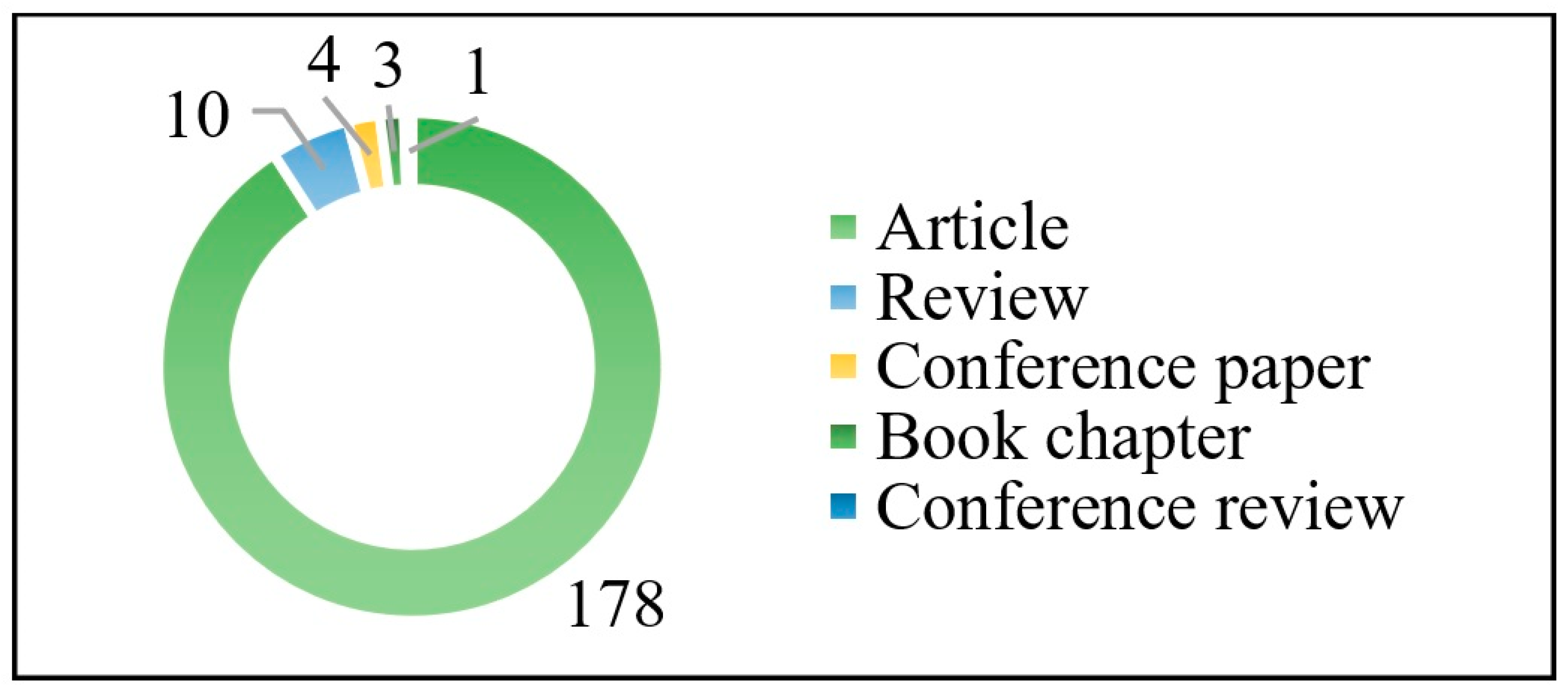

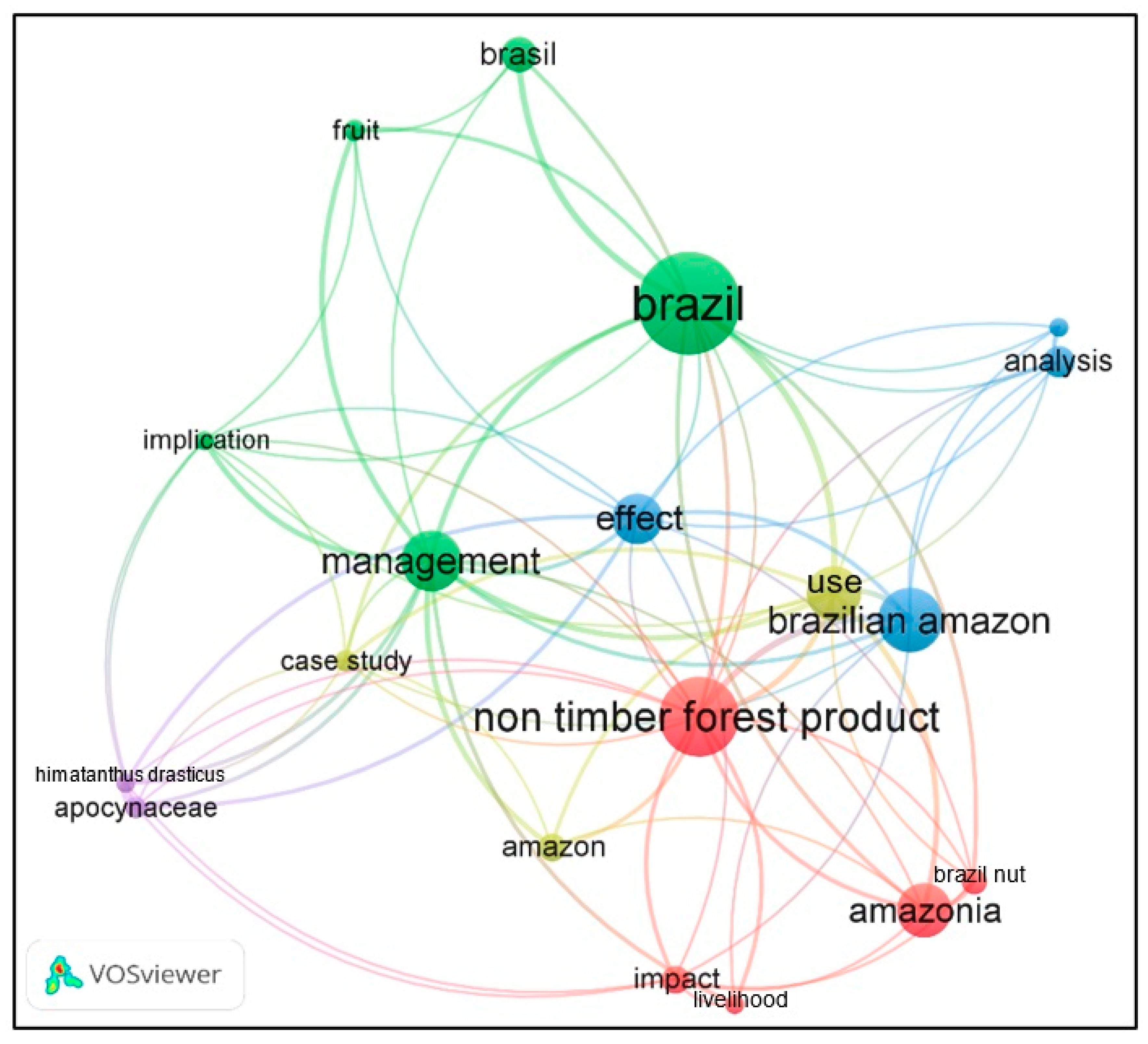
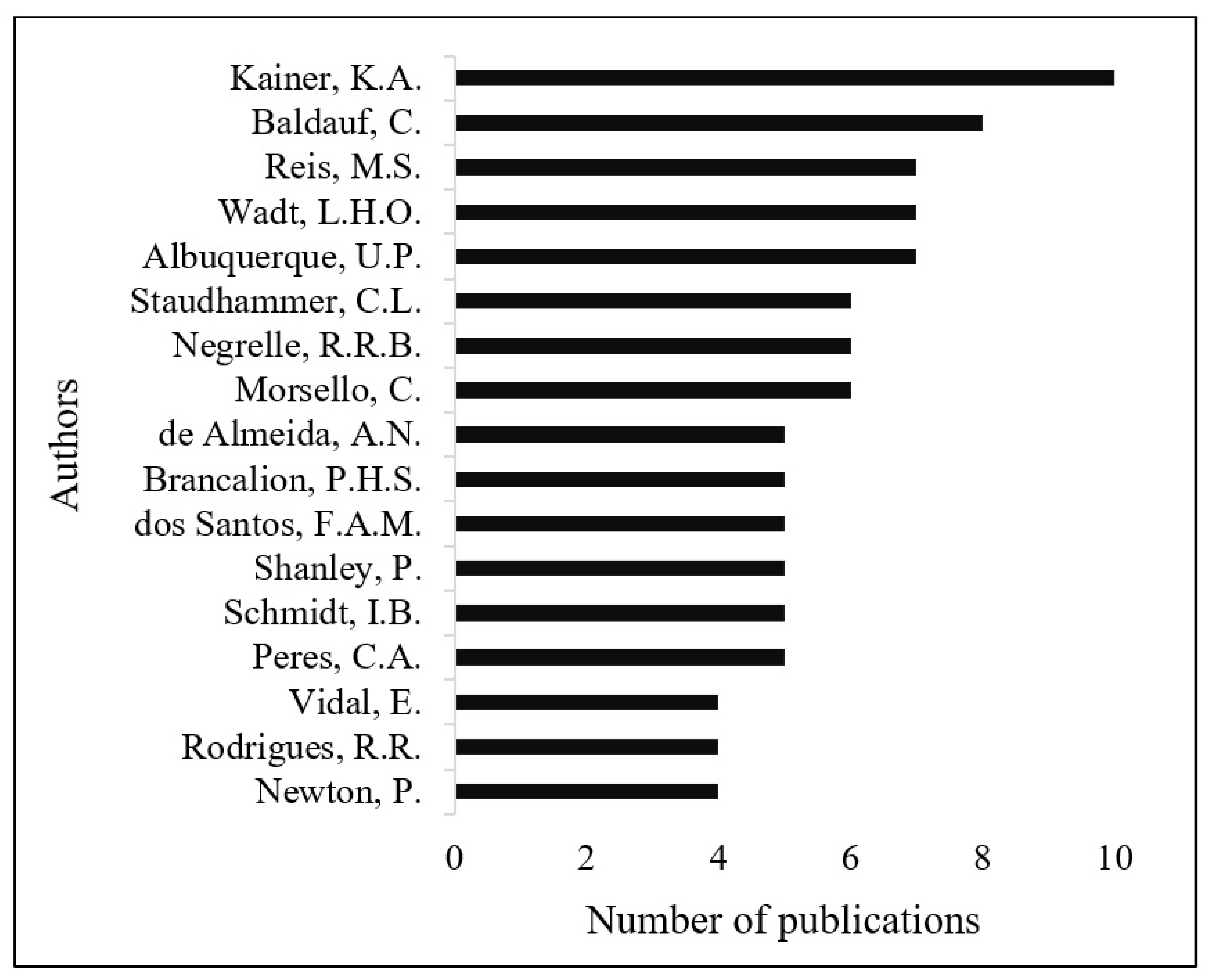




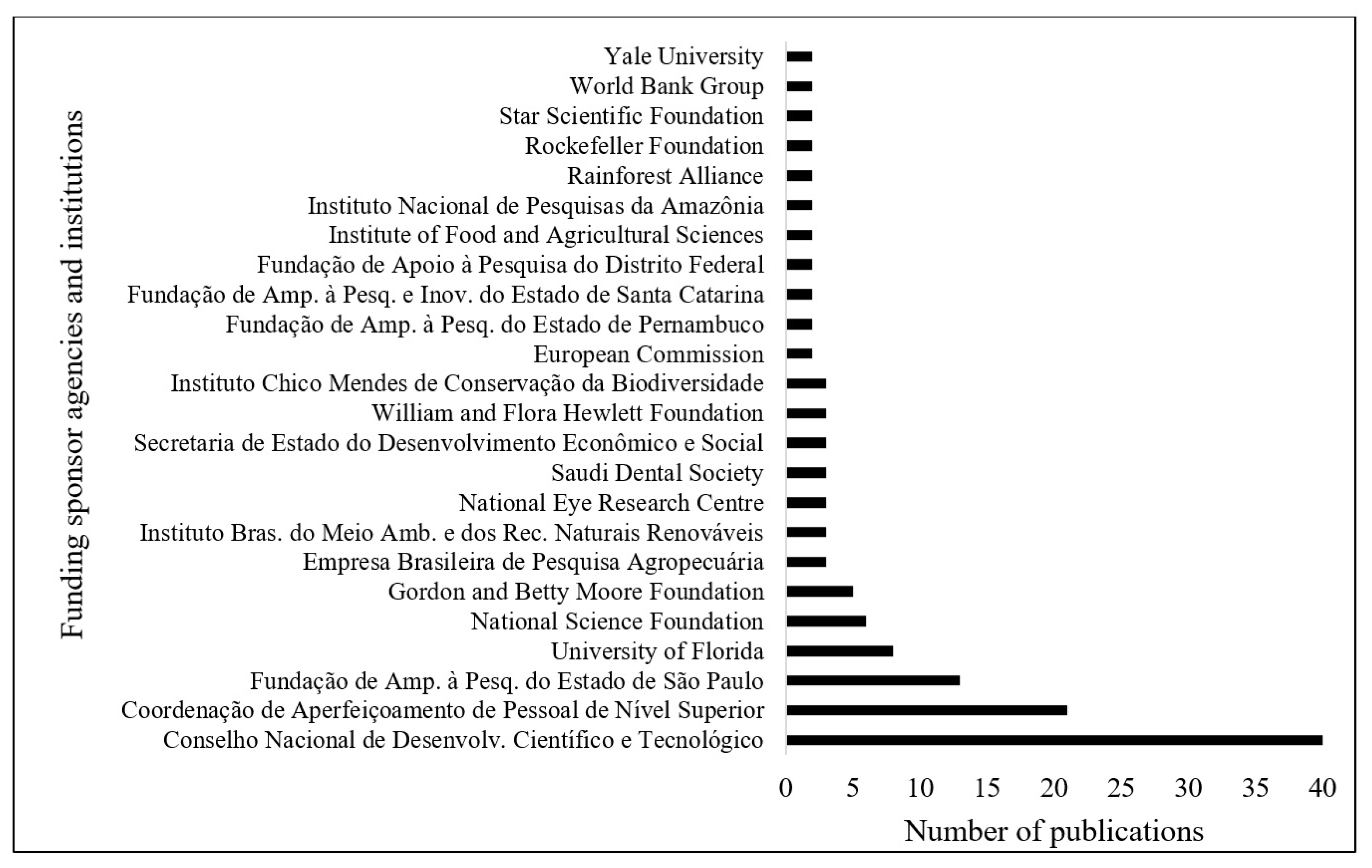

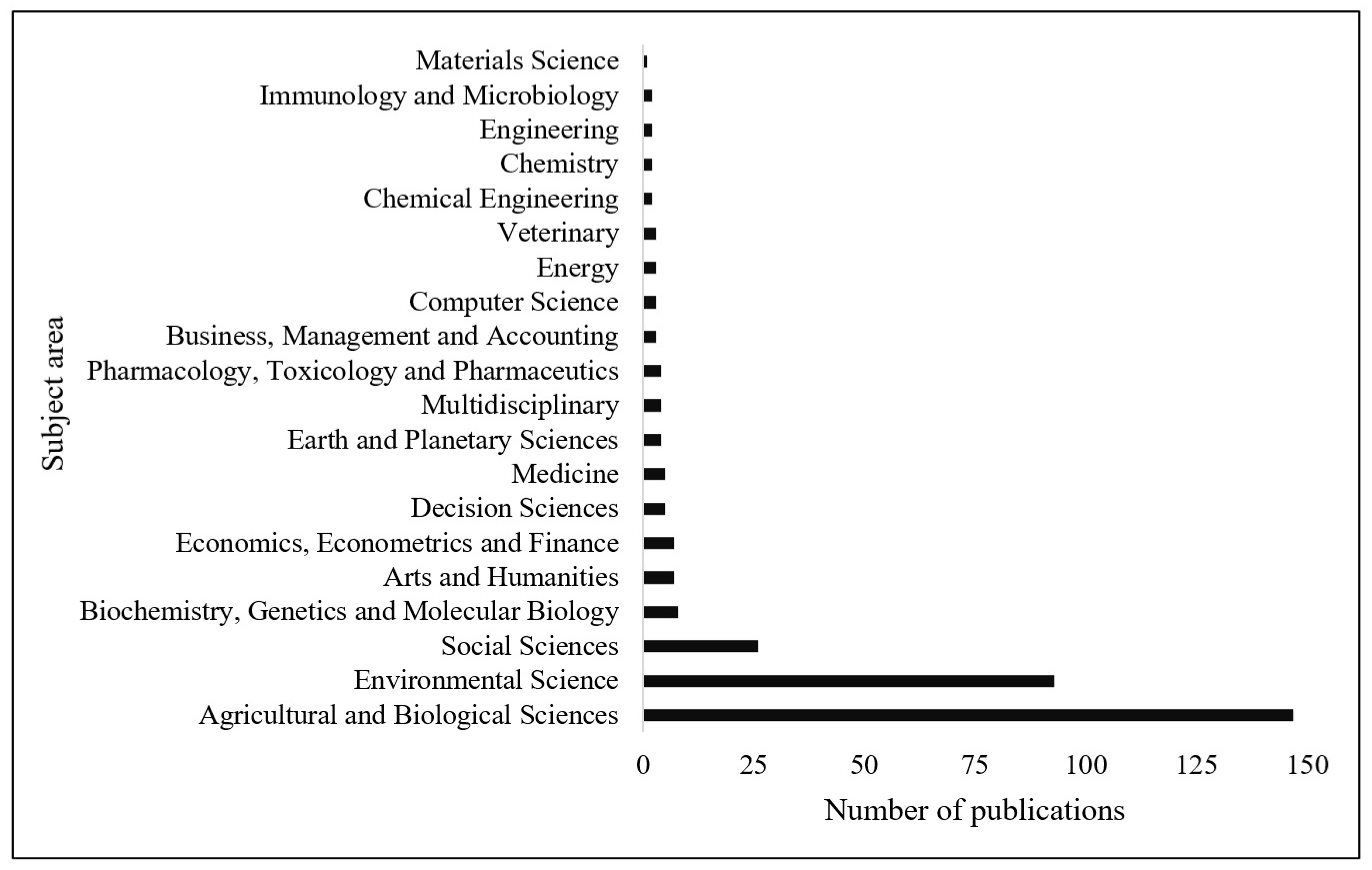

| Areas of Forest Science | Publications (%) |
|---|---|
| Nature Conservation | 35.97 |
| Forest Economy, Administration, Legislation and Policy | 28.06 |
| Management of Native and Planted Forests | 25.30 |
| Technology and Use of Forest Products | 6.72 |
| Forestry/Silviculture | 3.95 |
| Species | Scientific Name | N. | Species | Scientific Name | N. |
|---|---|---|---|---|---|
| Brazil nut | Bertholletia excelsa | 34 | Butiá | Butia purpurascens | 1 |
| Açaí | Euterpe oleracea | 13 | Cauaçu | Calathea lutea | 1 |
| Copaíba | Copaifera sp. | 10 | Sapucainha | Carpotroche brasiliensis | 1 |
| Juçara-palm | Euterpe edulis | 9 | Copaíba 1 | Copaifera langsdorffii | 1 |
| Andiroba | Carapa guianensis | 8 | Copaíba 2 | Copaifera multijuga | 1 |
| Pequi | Caryocar brasiliense | 8 | Liana 2 | Desmoncus polyacanthos | 1 |
| Janaguba | Himatanthus drasticus | 7 | Fava d’anta | Dimorphandra gardneriana | 1 |
| Buriti | Mauritia flexuosa | 7 | Cumaru | Dipteryx odorata | 1 |
| Rubber tree | Hevea brasiliensis | 6 | Cataia | Drimys brasiliensis | 1 |
| Araucaria | Araucaria angustifólia | 5 | Pitanga | Eugenia uniflora | 1 |
| Babassu | Attalea speciosa | 5 | Liana | Forsteronia glabrescens | 1 |
| Palm’s heart | Euterpe sp. | 4 | Bamboo 1 | Guadua sarcocarpa | 1 |
| Titica vine | Heteropsis flexuosa | 3 | Bamboo 2 | Guadua weberbaueri | 1 |
| Cashew | Anacardium occidentale | 2 | Jatobá | Hymenaea spp. | 1 |
| Pequiá | Caryocar villosum | 2 | Ingá | Inga capitata | 1 |
| Uxi | Endopleura uchi | 2 | Palm tree 1 | Iriartella setigera | 1 |
| Açaí-da-mata | Euterpe precatória | 2 | Arumã | Ischnosiphon gracilis | 1 |
| Mangaba | Hancornia speciosa | 2 | Cortiça | Kielmeyera coriacea | 1 |
| Vine | Heteropsis spp. | 2 | Arnica | Lychnophora ericoides | 1 |
| Vine 1 | Heteropsis macrophylla | 2 | Maçaranduba | Manilkara spp. | 1 |
| Vine 2 | Heteropsis spruceana | 2 | Deer | Mazama sp. | 1 |
| Vine 3 | Heteropsis steyermarkii | 2 | Canela | Nectandra grandiflora | 1 |
| Vine 4 | Heteropsis tenuispadix | 2 | Palm tree 2 | Oenocarpus bacaba | 1 |
| Seringueira | Hevea spp. | 2 | Palm tree 3 | Oenocarpus bataua | 1 |
| Erva-mate | Ilex paraguariensis | 2 | Palm tree 4 | Oenocarpus minor | 1 |
| Arumã | Ischnosiphon polyphyllus | 2 | Amapá amargo | Parahancornia fasciculata | 1 |
| Samambaia-de-folha | Rumohra adiantiformis | 2 | Cipó-preto | Philodendron corcovandense | 1 |
| Capim dourado | Syngonanthus nitens | 2 | Cataia/canela | Pimenta pseudocaryophyllus | 1 |
| Bromeliad 1 | Aechmea nudicaulis | 1 | Papiroba | Piper gaudichaudianum | 1 |
| Liana 1 | Amphilophium paniculatum | 1 | Bacuri | Platonia insignis | 1 |
| Cana de aniba | Aniba canelilla | 1 | Breu | Protium sp. | 1 |
| Tucuma | Astrocaryum aculeatum | 1 | Aroeira | Schinus terebinthifolius | 1 |
| Murumuru | Astrocaryum murumuru | 1 | Espinheira santa | Sorocea bonplandii | 1 |
| Palmeira tucumã | Astrocaryum tucuma | 1 | Esfagno | Sphagnum sp. | 1 |
| Acuri | Attalea phalerata | 1 | Barbatimão | Stryphnodendron rotundifolium | 1 |
| Pupunha-palm | Bactris gasipaes | 1 | Cobrina | Tabernaemontana catharinensis | 1 |
| Palmeira 1 | Bactris marajá | 1 | Candombá | Vellozia sincorana | 1 |
| Bromeliad 2 | Bromelia antiacantha | 1 | Bromeliad 3 | Vriesea incurvata | 1 |
© 2020 by the authors. Licensee MDPI, Basel, Switzerland. This article is an open access article distributed under the terms and conditions of the Creative Commons Attribution (CC BY) license (http://creativecommons.org/licenses/by/4.0/).
Share and Cite
Silva, T.C.; Araujo, E.C.G.; Lins, T.R.d.S.; Reis, C.A.; Sanquetta, C.R.; Rocha, M.P.d. Non-Timber Forest Products in Brazil: A Bibliometric and a State of the Art Review. Sustainability 2020, 12, 7151. https://doi.org/10.3390/su12177151
Silva TC, Araujo ECG, Lins TRdS, Reis CA, Sanquetta CR, Rocha MPd. Non-Timber Forest Products in Brazil: A Bibliometric and a State of the Art Review. Sustainability. 2020; 12(17):7151. https://doi.org/10.3390/su12177151
Chicago/Turabian StyleSilva, Thiago Cardoso, Emmanoella Costa Guaraná Araujo, Tarcila Rosa da Silva Lins, Cibelle Amaral Reis, Carlos Roberto Sanquetta, and Márcio Pereira da Rocha. 2020. "Non-Timber Forest Products in Brazil: A Bibliometric and a State of the Art Review" Sustainability 12, no. 17: 7151. https://doi.org/10.3390/su12177151
APA StyleSilva, T. C., Araujo, E. C. G., Lins, T. R. d. S., Reis, C. A., Sanquetta, C. R., & Rocha, M. P. d. (2020). Non-Timber Forest Products in Brazil: A Bibliometric and a State of the Art Review. Sustainability, 12(17), 7151. https://doi.org/10.3390/su12177151





